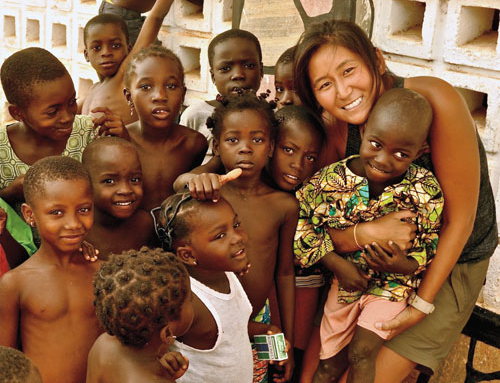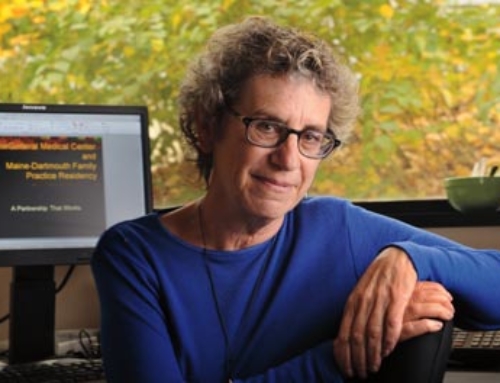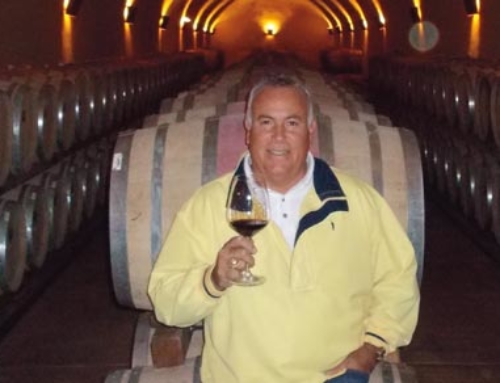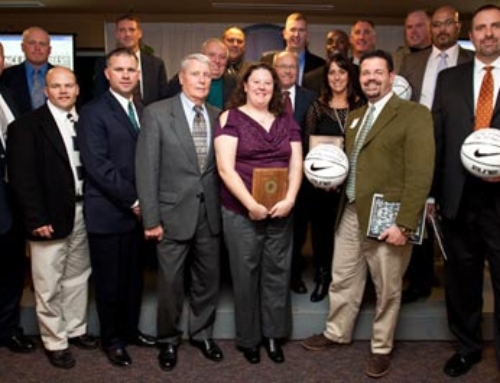
While I was at the University of Virginia as a graduate instructor, I really came to understand how much teaching is a part of who I am. We were being encouraged to pursue careers at large research universities, but … when the time came to look for my first job, I ended up teaching at a small college in western Pennsylvania called Washington & Jefferson.
In high school, as I was trying to figure out what my life’s calling would be, I thought that perhaps I had a religious vocation. I joined the Xaverian Brothers and spent one-and-a-half years in Danvers, Mass., at their house of formation. That was a wonderful experience, a really formative time in my life. However, I eventually came to understand that it was not what I was called to do.
In the meantime, I had begun to attend Boston College and continued there and decided what I really wanted to be when I grew up was a college professor. BC had a program that allowed me to earn both my bachelor’s and my master’s in four years with a couple of summers thrown in. From there, I went down to the University of Virginia, where I worked on my Ph.D. in literature.
I began as an assistant professor of English at Washington & Jefferson in 1989. I was at W & J for 16 years and, during that time, I did pretty much everything a person could do as a professor and an administrator. My experience there, and later at the College of Saint Elizabeth, confirmed for me that the smaller college, liberal arts environment was where I could best serve.
What did you do as an administrator prior to coming here?
Early in my time at Washington & Jefferson, I was the director of the freshman writing program, and then I also got involved in the first-year seminar program called Freshman Forum, which was a team-taught course with faculty from departments all over campus.
They asked me to run the forum, and that was a major factor in my emerging understanding of how I could best serve the higher education community. Speaking with colleagues from all over campus gave me a good sense of the diversity of faculty perspectives. And it also let me understand I had some ability in coordinating, organizing and setting up programs … and having them work reasonably well.
After four years, I went back to teaching English full time for about a year. Then the Dean asked me to serve as associate dean. It wasn’t intended to be a long-term commitment … I thought of it in terms of community service. One year led to another, and at some point I discovered I had spent more time as a full-time administrator than as a full-time faculty member. So that was one of those moments when I said, “I have to figure out what I’m going to be when I grow up.”
What else did you get involved with at Washington & Jefferson?
I had leadership roles in assessment, self-study and master planning projects. At one point for six months, I actually had responsibility for the physical plant. I was eventually promoted to associate vice president of academic affairs, where I had responsibility for information technology, for the library, for faculty development and for student concerns. I got to see the institution from a broader perspective than one might ordinarily, and that was interesting and exciting.
I came to appreciate how complex things are, even in a small college environment. My work with the Middle States Commission on Higher Education allowed me to visit and learn about other colleges. All of this gave me a good understanding of the challenges and opportunities that smaller colleges face.
How did your varied experiences lead to where you are today?
Being part of the leadership team at W & J for a number of years was very formative. So I figured, “Okay, this is what I’m supposed to be. Let’s focus on this with greater intention.” My thinking led me to recognize the importance of having a set of compelling, shared understandings that ground how we work together and what we do. Being an intentional community gives us the chance to be a more effective community. And I came increasingly to appreciate the energy and power of a clearly articulated set of collective values that we find on our best days in the context of Catholic higher education.
Eventually, I accepted a position as vice president for academic affairs at College of Saint Elizabeth in Morristown, N.J., where I had the chance to put some of these ideas to the test.
Tell us about your key work at the College of Saint Elizabeth.
One of the challenges that all small colleges face right now, especially Catholic ones, is how to organize for the 21st Century. I spent a lot of time at Saint Elizabeth working on that.
In the history of smaller Catholic colleges, there are striking parallels. Most of us began as single-sex institutions. In the ’60s and ’70s, changes in the world meant we needed to think larger in order to remain viable. The move to co-ed, adult, or weekend programs began. Those opportunities turned out to be positive and allowed the colleges to grow. But over time we colleges ended up with organizational structures similar to a country farmhouse after two centuries. At the beginning, there was a main building with a clear organization, and then various outbuildings were added. After a century, a collection of structures exists and works, but in strange ways.
How did you decide to become a college president?
I’ve thought a great deal about leadership over the years, and it was inevitable that I would think about, “What is the next thing, if there’s a next thing?” Over the years, a number of people asked me if a presidency was something I aspired to, and, for a long time, my answer was “No, not me.” But over time it became clearer and clearer that the notion was something I needed to take seriously.
In the summer of 2011, my wife Melissa and I had the chance to participate in a Council of Independent Colleges seminar on presidential mission and vocation. Right now, there’s a lot of energy focused on where our next generation of leaders is coming from, especially for small colleges, because we are really the most fragile part of the ecosystem – places that don’t have large endowments and that are heavily student-revenue dependent.
We spent a week discussing a series of readings and exploring some of the big issues, and then followed up with a series of phone conversations with one of the presidents leading the seminar. We concluded with another group session in February. It was a very deep and rich experience. And it very much helped to confirm this growing sense that this was my vocation. It might sound hokey, but I think of this as a vocation. We use the word “vocation” in many ways today, but in its deepest sense it points to an alignment of skills, interests, attitudes and dispositions. The sense of calling pushes it beyond being a job, a career. It’s an overwhelming commitment to the work.
That gets us back to the notion of one of the attractions of Catholic colleges – the tenets of Catholic social teaching. They remind us what it means to be a fully alive human being. One of them is the dignity of work – all work – and the fulfillment of human potential in work done in ways that allows us to express our individuality and to have that recognized.
Everything we do in higher education should be about meaningful work. We used to tell students that they would have four or five jobs over the course of their careers. Now they may have two or three careers over the course of their lives. One of the benefits of liberal arts education is that it allows us to really see opportunities, to make connections, to explore possibilities in ways that narrowly defined vocational or career training simply doesn’t. It’s not meant to end with graduation day; it’s meant to continue over a very long time.
When I gave an introduction recently at a Maine Development Foundation event on campus, I talked about the alignment of entrepreneurial thinking with liberal arts thinking. It’s exactly the same impulse.
How would you describe your leadership style and strengths?
People have said I’m a good listener. It’s not always been one of my strengths; I have really made an effort to improve. I also think I have a capacity for thinking creatively, for seeing new possibilities. I like to believe that’s part of my own liberal arts education.
I try to be collaborative. I believe strongly in teams and teamwork, in focused project work. And I think part of listening is a deeply held notion that everyone should have a chance to be part of the conversation, that there aren’t privileged places at the table. That’s what I believe about teaching as well.
I also have a very strong capacity to imagine and am committed to the hard work that allows ideas to take concrete shape.
How do you relax?
Well, we love the outdoors. It’s great to be so close to all kinds of water and amazing places to explore. I also love cooking … putting things together in new and interesting ways. And, of course, playing with Matthew … He has his own kind of insistence, so it’s “Sit down, Daddy. Play trains!”
What do you like to cook?
For a period, I was big into bread-making, then there was a period where I was doing soups and stews. For the last seven years, the kitchen was a little small and I was suffering with a 1960s electric range. Now we have a gas range and more work space, so we’ll have to see what emerges next.
Do you have time to read?
For the past few months, I haven’t had a lot of time to read outside of what I read for work. In fact, I haven’t been able to find the books! We have about 60 cartons of books in the garage waiting for some bookshelves.
Before we packed up, there was a foot-and-a-half-tall stack of books on the table next to the bed. I tend to read various things at the same time. In that stack were all kinds of things – a great book by Susan Cain called “Quiet,” Bill Bryson’s “At Home,” a book by Thich Nhat Hanh, a Vietnamese Buddhist Zen master, and Parker Palmer’s “Let Your Life Speak.”
How would you describe the college’s strengths and challenges?
If you read enough college and university strategic plans, you come to realize that most institutions want to be distinctive in exactly the same three ways! However, one of the ways to be truly distinctive is to be of the place you find yourself, because there’s no one else here but us. Saint Joseph’s College has an incredible location with the lake on one side and our farm on the other. We need to think more about where we are and how we can bring the pieces together in a compelling vision.
What we’re doing in the online programs is very exciting. The fact that we’re doing it so well is a real strength of the college, but it also allows us to think constructively about the future of how we offer programs. We have to move beyond the “online over here” and “4-year over here.” We have to bring those two realities together.
We need to be much more open to the needs of people. Can we have a three-year program? Absolutely. We can take advantage of both online and on-campus to create a compelling three-year program … or a five-year or a four+-year program. There’s no reason not to blend, in substantial ways, the online and on-campus programs.
Also, there aren’t too many careers that won’t demand that workers upgrade their skills using online learning methods, and we can bring a richer array of (online) offerings for all kinds of learners.
What do you believe is Saint Joe’s biggest strength?
Our most important strength is our people. One of the biggest reasons I’m here is that from the first moment I stepped on campus, I felt instantly at home. There are really committed people here. You can have the best buildings and the newest technology in the world … all the right stuff, but if you don’t have people committed to the institution, you’re not going to get very far.
And that’s not just faculty and staff and students, but it’s also the graduates of the college, friends of the college. Over the next several years, we will focus on our people as a core asset.
A key part of your role is fundraising. Tell us about your approach to that.
You’re really asking people for support of all different kinds, and money is one of those kinds. If I ask for money, I want to be clear that we’re using all the money we have in the most effective ways. People work hard for their money and when they get to the place where they can help others, they have every reason to expect that the places they support are treating them and their resources with absolute respect. So it’s an issue of respect and stewardship.
If I know that our programs are efficient and productive and infused with the values of the college, then it’s not a problem to ask for money. It really comes out of a deeply held pride and conviction that what we’re doing is worthy of support.
And we’re offering donors to become a partner in this process with us. We want donors to be an ongoing part of this, to bring them into that conversation, into this larger exploration of what it means to be a Catholic liberal arts college in the Mercy tradition in the 21st Century.
Tell us about that larger exploration.
I think that’s ultimately what we’re talking about … developing a new model for smaller college education that can be a place where people can come for any length of time … a weekend, an hour, four years, five years, multiple degrees over the course of a lifetime.
We don’t know yet for sure what the Catholic liberal arts college of the 21st Century will look like. It has to have the best features of the past, but be innovative and creative … and forward-looking. There are a lot of sailboats in this office, and they are a compelling image for me of the kind of organization that we need to work toward becoming. Universities are often described as being like ocean liners that take miles to turn. Sailboats are much more nimble – they have to be in order to respond to an ever-changing environment.
There’s also something beautiful about the way sailboats move.
by Charmaine Daniels



